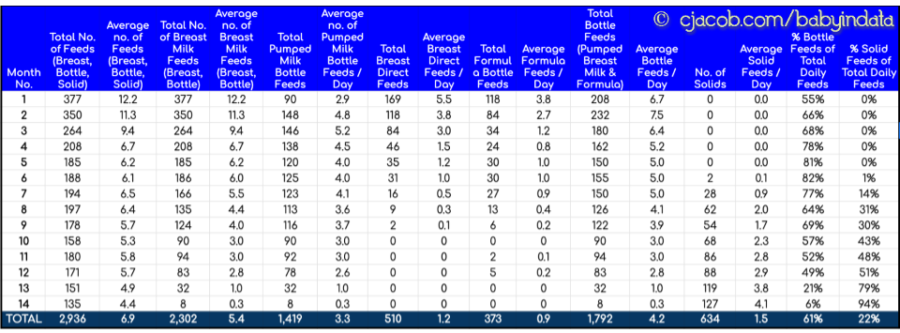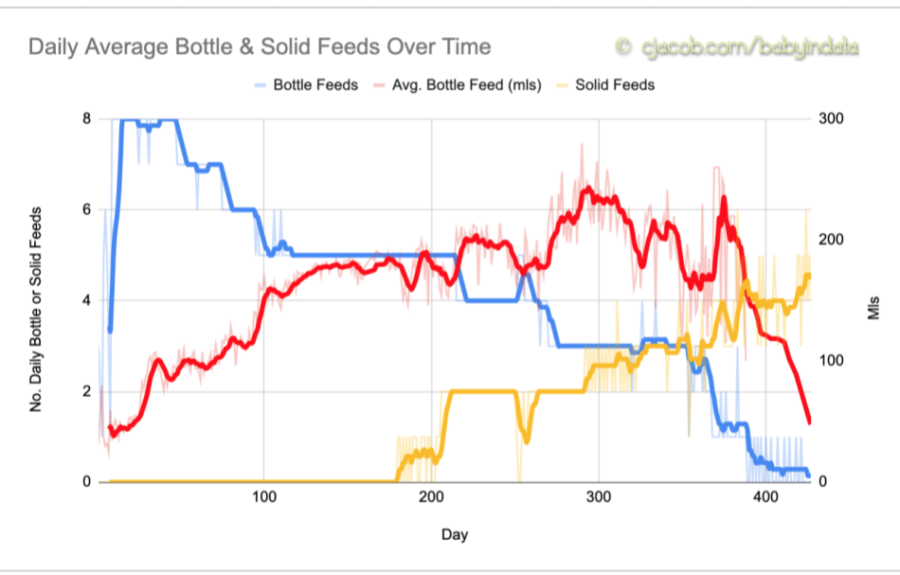The primary purpose of this post is to document how daily baby feeding changes over time. A question we often ask “experts,” more seasoned parents, and ourselves, is how many times or how often should I feed my baby per day? Then, that question evolves into: when can I start feeding them less frequently, and how does that change over time or over the baby’s first year or so of life?
Well, let’s take a step back and firstly direct you to our overview post on our A Baby Feeding Journey over 14 Months (a 12 Part Series), which covers the first 14 months of our baby’s life. We created this series in hopes of giving others a very basic benchmark and anecdotal information that they could use while raising their little ones.
Now, we have look at the evolution of feeding in 14 Months of Feeding a Baby in Data, A 1+ Year Breast Pumping Journey and Pumped Breast Milk vs. Formula in Data, but we focused more on the amount of feeding and time spent. Today, we want to talk about the types of feeding that happened each month, and how that changed (and reduced) in frequency over time. Hopefully, this gives those who are early in the parenting journey a sense of when they can anticipate seeing light at the end of the tunnel, when they are sleep deprived and feeling like they are in a never-ending loop of feeding and diaper changes.
Table 1: Daily Average Baby Feeds For Breast, Pumped Milk, Formula & Solids

Chart 1: Daily Average Bottle & Solid Feeds (7-day moving average)

Some Highlights:
- In month 1, we were feeding our baby on average 12x per day, and a little under 7x of these feeds were bottle feeds (55% of feeds). In the above posts, we discussed the erratic nature of month 1, our baby’s weak suck, and our nursing and (breast milk) pumping journey, which contribute to this “very frequent” feed schedule. This included a very heavy and intense “triple feeding” period (this feeding process encompasses baby first nursing on breast, then is “topped up” with either pumped breast milk and/or formula; finally, mom pumps breast milk. In the beginning, this is typically at least every three hours around the clock).
- Now by month 2, we started to get into a routine, and almost 8x (7.5x) a day, or every 3 hours we were bottle feeding our daughter. There were still, on average, 11x feeds a day. But as we noted in other posts, it became clear our baby was getting most of her nutrients from pumped breast milk and formula in bottles, rather than directly from the boob.
- From months 4 to 7, you can see we were trending down to 5x bottle feeds per day, and you can see the more daily trending decline in the chart. As we noted in other posts, month 6 was peak bottle feeding, with 27,955 mls (27.955 litres or 945 oz) or 902 mls per day (30.5 oz / day). You can see the pumped breast milk vs. formula breakdown in Pumped Breast Milk vs. Formula in Data.
- Then by months 8-9, we went down to 4x bottle feeds per day, and to round out year 1, from months 10-12 it is about 3x per day. Again, you can see the more daily nuanced trend in the chart over these periods.
- We talked about how supply reduced dramatically in A 1+ Year Breast Pumping Journey in Data, during month 13 and then further in month 14 (Year 2). So you can see the amount of bottle feeds reduced a lot to 1x a day in month 13 and then 0.3x a day or once every 4 days in month 14.
- During this bottle feeding journey, you can see that while feeding declined, the average amount consumed (pumped breast milk + formula) rose dramatically per feed. In month 1, this was 54 mls (1.8 oz) per bottle, but this rose almost 200% (or 3x) by month 4, when baby was drinking 153 mls (5.2 oz) per bottle.
- By month 10, when solids were a much bigger part of her diet, and when she was drinking bottles (almost all breast milk – 98%), baby’s 3 bottles per day were averaging about 229 mls (7.7 oz).
- Just as a basis of benchmark, we included some Bobbie data (as discussed in our Pumped Breast Milk vs. Formula in Data post, Bobbie is a U.S. infant formula company that models their product off the European style formulas and ingredients). You can see that while their frequency and average amounts consumed are broad, and that this is based on a formula-only diet, the change in amount of feeds over time follows a similar pattern.
- Regarding solid feeds, you can see we went from 1x per day in month 7 to about 2x per day from months 8-10, and then to about 3x per day in months 11 and 12 to end year 1.
- In months 13 and 14, we started to include extra solid feeds that were more snack-time/cow milk substitute feeds, as our baby’s appetite grew and our pumped breast milk supply was decreasing. So this explains the increase to about 4x solids per day in months 13 and 14.
- By month 14, 94% of all of her feeds in total were solid feeds. This was only 51% just 2 months earlier in month 12, and 30% in month 9.
